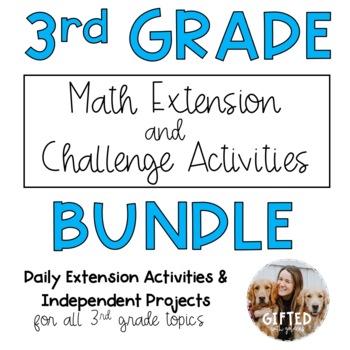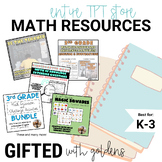ENTIRE YEAR 3rd Grade Math Extensions Bundle - Gifted/Advanced
- Zip
What educators are saying
Products in this Bundle (6)
showing 1-5 of 6 products
Also included in
- Are you a Gifted Teacher that works with many grade levels looking for a large supply of MATH resources?This bundle would be perfect for you! BEST PART? It will continue to grow and include ALL FUTURE Math Resources! **Make sure to purchase it NOW and receive all future notifications to re-downloadPrice $100.00Original Price $132.50Save $32.50
Description
3rd Grade Math: Advanced and Gifted Extensions Bundle
These resources support deeper thinking for 3rd grade students in Math that need to be challenged to think deeper and more critically - not just jump to next grade level math skills.
Includes:
- Addition and Subtraction
- Multiplication and Division
- Area and Perimeter
- Fractions
- Geometry
- Measurement & Data (Time, Rulers, Volume/Mass, Graphs)
Some of my favorite ways to use it are for independent extensions, group collaboration work, small group projects, warm up challenges, end of the year extension projects and more! It is great for gifted students who need something MORE than the curriculum.
**IMPORTANT 4TH GRADE NOTE: I have used this with my 4th grade students as extensions to their units as well. Many 4th grade math standards build on 3rd grade standards, therefore these units are great extensions! Feel free to reach out to me at giftedwithgoldens@gmail.com if you would like to know more about using these with your 4th graders!
Interested in the 2nd Grade Bundle? Check it out here!
This bundled unit has been used by myself, my classroom teachers, and many teachers around the US. I have gotten great feedback, check it out!
" These are such great projects for my gifted students to apply their learning. I love that they are just print & go. They were engaged and able to use their knowledge in real-world ways. Thank you!" - Courtney W.
" This was an excellent resource for my gifted and fast finishers. They were able to use this resource with very little direction. My students and I are very pleased with the activities. I would use this resource again and again." - Darlene P.
"I used these resources with my 3rd grade math enrichment group. There are engaging, real-world problems. So much better than a one-and-done worksheet. Highly recommend!!!!!!" -Allison G
"This is a great resource for my students who had already mastered much of our addition and subtraction unit. Thank you!" - For the Love of Birds
Below are the standards addressed in this bundle so far:
CCSS3.MD.C.5
Recognize area as an attribute of plane figures and understand concepts of area measurement.
CCSS3.MD.C.5a
A square with side length 1 unit, called “a unit square,” is said to have “one square unit” of area, and can be used to measure area.
CCSS3.MD.C.5b
A plane figure which can be covered without gaps or overlaps by unit squares is said to have an area of square units.
CCSS3.MD.C.6
Measure areas by counting unit squares (square cm, square m, square in, square ft, and improvised units).
CCSS3.MD.C.7
Relate area to the operations of multiplication and addition.
CCSS3.MD.C.7a
Find the area of a rectangle with whole-number side lengths by tiling it, and show that the area is the same as would be found by multiplying the side lengths.
CCSS3.MD.C.7b
Multiply side lengths to find areas of rectangles with whole-number side lengths in the context of solving real world and mathematical problems, and represent whole-number products as rectangular areas in mathematical reasoning.
CCSS3.MD.D.8
Solve real world and mathematical problems involving perimeters of polygons, including finding the perimeter given the side lengths, finding an unknown side length, and exhibiting rectangles with the same perimeter and different areas or with the same area and different perimeters.
CCSS3.NBT.A.2
Fluently add and subtract within 1000 using strategies and algorithms based on place value, properties of operations, and/or the relationship between addition and subtraction.
CCSS3.NBT.A.3
Multiply one-digit whole numbers by multiples of 10 in the range 10–90 (e.g., 9 × 80, 5 × 60) using strategies based on place value and properties of operations.
CCSS3.OA.A.1
Interpret products of whole numbers, e.g., interpret 5 × 7 as the total number of objects in 5 groups of 7 objects each. For example, describe a context in which a total number of objects can be expressed as 5 × 7.
CCSS3.OA.A.2
Interpret whole-number quotients of whole numbers, e.g., interpret 56 ÷ 8 as the number of objects in each share when 56 objects are partitioned equally into 8 shares, or as a number of shares when 56 objects are partitioned into equal shares of 8 objects each. For example, describe a context in which a number of shares or a number of groups can be expressed as 56 ÷ 8.
CCSS3.OA.A.3
Use multiplication and division within 100 to solve word problems in situations involving equal groups, arrays, and measurement quantities, e.g., by using drawings and equations with a symbol for the unknown number to represent the problem.
CCSS3.OA.A.4
Determine the unknown whole number in a multiplication or division equation relating three whole numbers. For example, determine the unknown number that makes the equation true in each of the equations 8 × ? = 48, 5 = __ ÷ 3, 6 × 6 = ?.
CCSS3.OA.B.5
Apply properties of operations as strategies to multiply and divide. Examples: If 6 × 4 = 24 is known, then 4 × 6 = 24 is also known. (Commutative property of multiplication.) 3 × 5 × 2 can be found by 3 × 5 = 15, then 15 × 2 = 30, or by 5 × 2 = 10, then 3 × 10 = 30. (Associative property of multiplication.) Knowing that 8 × 5 = 40 and 8 × 2 = 16, one can find 8 × 7 as 8 × (5 + 2) = (8 × 5) + (8 × 2) = 40 + 16 = 56. (Distributive property.)
CCSS3.OA.B.6
Understand division as an unknown-factor problem. For example, find 32 ÷ 8 by finding the number that makes 32 when multiplied by 8.
CCSS3.OA.C.7
Fluently multiply and divide within 100, using strategies such as the relationship between multiplication and division (e.g., knowing that 8 × 5 = 40, one knows 40 ÷ 5 = 8) or properties of operations. By the end of Grade 3, know from memory all products of two one-digit numbers.
CCSS3.OA.D.8
Solve two-step word problems using the four operations. Represent these problems using equations with a letter standing for the unknown quantity. Assess the reasonableness of answers using mental computation and estimation strategies including rounding.
CCSS3.OA.D.9
Identify arithmetic patterns (including patterns in the addition table or multiplication table), and explain them using properties of operations. For example, observe that 4 times a number is always even, and explain why 4 times a number can be decomposed into two equal addends.
CCSS3.NF.A.1
Understand a fraction 1/ as the quantity formed by 1 part when a whole is partitioned into equal parts; understand a fraction / as the quantity formed by parts of size 1/.
CCSS3.NF.A.3
Explain equivalence of fractions in special cases, and compare fractions by reasoning about their size.
CCSS3.NF.A.3a
Understand two fractions as equivalent (equal) if they are the same size, or the same point on a number line.
CCSS3.NF.A.3b
Recognize and generate simple equivalent fractions, (e.g., 1/2 = 2/4, 4/6 = 2/3). Explain why the fractions are equivalent, e.g., by using a visual fraction model.
CCSS3.NF.A.3c
Express whole numbers as fractions, and recognize fractions that are equivalent to whole numbers. Examples: Express 3 in the form 3 = 3/1; recognize that 6/1 = 6; locate 4/4 and 1 at the same point of a number line diagram.
CCSS3.NF.A.3d
Compare two fractions with the same numerator or the same denominator by reasoning about their size. Recognize that comparisons are valid only when the two fractions refer to the same whole. Record the results of comparisons with the symbols >, =, or <, and justify the conclusions, e.g., by using a visual fraction model.
3.G.A.1
Understand that shapes in different categories (e.g., rhombuses, rectangles, and others) may share attributes (e.g., having four sides), and that the shared attributes can define a larger category (e.g., quadrilaterals). Recognize rhombuses, rectangles, and squares as examples of quadrilaterals, and draw examples of quadrilaterals that do not belong to any of these subcategories.



